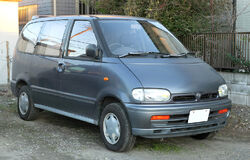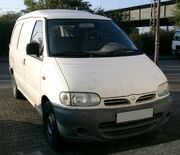m (...) |
m (cat) Tag: sourceedit |
||
| Line 105: | Line 105: | ||
[[Category:Vehicles with four wheel steering]] |
[[Category:Vehicles with four wheel steering]] |
||
[[Category:Vehicles introduced in 1991]] |
[[Category:Vehicles introduced in 1991]] |
||
| + | [[Category:Trucks built in Japan]] |
||
Latest revision as of 20:36, 4 May 2015
The Nissan Serena started life as a very small people carrier, but grew larger with each generation over the years. Earlier versions were FR layout with a live axle mounted on leaf springs. Later versions had a multilink independent rear suspension, and were FF layout or 4WD. The most popular version was the 2.3 diesel engine version and it was unusual in that it had eight seats instead of the expected seven.
MkI C23 series (1991-2001)
 | |
| Manufacturer | Nissan Motors |
|---|---|
| Also called | Nissan Vanette Serena |
| Production | 1991 - 2002 |
| Class | Van |
| Related | LDV Cub |
In European markets, the C23 Serena had 1.6 or 2.0 L petrols, or 2.3 L diesel engines. Trim levels were LX, SLX, SGX and SGXi.
Until around 2002, the standard petrol engine was an SR20DE. In the early nineties, Nissan produced a version with the turbocharged SR20DET to carry people very rapidly.[1][citation (source) needed] From 2002 onwards the Serena used the QR20DE and QR25DE. A variety of other engines were used over the years, including diesels specifically the CD20 (for the commercial van version), CD20T 1973 cc Diesel Turbo and CD20ET.
Models were manufactured in Japan from 1991 onwards, and many were imported into Australasia and the United Kingdom. Nissan produced many different trim levels - FX, SX etc. Full-Auto (full time) 4WD versions were also produced providing greater stability and better handling. The 2.3 non turbo diesel was never manufactured for the Japanese market and its seating arrangement and interior fittings are not the same as the 2.0 petrol (SR20DE), 2.0 Diesel CD20 and Turbo Diesel CD20T models manufactured in Japan for the local market.
Auto Express once named the Serena as the slowest passenger car in the benchmark 0-60 mph (now 62 mph) test, with the 2.3 diesel version (added in the mid 1990s) taking 27.8 seconds to reach that speed.
Throughout its production the C23 model underwent several facelifts although the interior design and body largely remained unchanged, for example, addition of air bags and bench seats for the second and third rows. Each facelift model can be identified by front grill design which was updated in 1994 and 1997.
Europe

Nissan Vanette Cargo
The Nissan Vanette was a series of small vans manufactured in Spain by Nissan Motors. The van was produced in two versions, the Vanette E, which shared the basic body shell with the Nissan Serena people carrier, differing only in not having rear windows and passenger seats, and the Vanette Cargo, which was longer and had a higher roof line from behind the front seats. The British van manufacturer LDV Limited entered into an agreement with Nissan to sell a re-branded version of the Vanette Cargo, this was sold in Britain as the LDV Cub.
The model was discontinued in 2001 and replaced by a re-badged version of the Opel Vivaro/Renault Trafic called the Nissan Primastar, which is produced in Luton, England and Barcelona, Spain.
Reputation
The Nissan Serena Mk1 is said to have an image problem by many, in particular Fifth Gear presenter Quentin Willson, who remarked in 1997 Top Gear episode that "...the Nissan Serena was about as seductive as a skip and as desirable as an old shoe."
Although the Nissan Serena handles better than most people perceive it to (due to its mid engine), its power to weight ratio is particularly poor as shown by the 0–100 km/h averages listed below. The only models with marginally acceptable acceleration are powered by the SR20DE engine.
Nissan Serena 1.6i 16v 1597cc 0–100 km/h 18 s
Nissan Serena 2.3 D J-V Pack 0–100 km/h 27.8 s
Nissan Serena C23 1998cc SR20DE 0–100 km/h 12.5 s
MkII C24 (2001-2003)
These versions had a facelift with a wider variety of engines and colours. In Taiwan the Serena C24 has been manufactured by Yulon under the Nissan label. The Nissan C24 was also manufactured by Edaran Tan Chong Motor Sdn Bhd in Kuala Lumpur, Malaysia.[2] In China, the Serena Mk. II got the name Dongfeng Yumsun and is produced by their subsidiary Zhengzhou Nissan Automobile.[3] since September 2007.
- Non facelift: 2.0L engine
- Facelifted: 2.5L engine
MkIII C25 (2003-2010)
 | |
| Manufacturer | Nissan Motors |
|---|---|
| Production | 2003-2010 |
| Layout | FF / 4WD |
| Engine(s) | 2.0 L MR20DE DI I4 |
| Transmission(s) | Xtronic CVT |
| Wheelbase | 2,860 mm (112.6 in) |
| Length | 4,650-4,725 mm (183.1-186.0 in) |
| Width | 1,695-1,725 mm (66.7-67.9 in) |
| Height | 1,840/1,850 mm (72.4-72.8 in) |
In 2007, 2008 and 2009, Serena C25 is the best selling minivan in Japan.
This model is also sold as the Suzuki Landy in Japan.
MkIV C26 (2010-present)
| Manufacturer | Nissan Motors |
|---|---|
| Production | 2010-present |
| Layout | FF / 4WD |
| Engine(s) | 2.0 L MR20DD DI I4 |
| Transmission(s) | Xtronic CVT |
| Wheelbase | 2,860 mm |
| Length | 4,685-4,770 mm |
| Width | 1,695-1,735 mm |
| Height | 1,865-1,875 mm |
The 2011 Nissan Serena was released in late November 2010 to the Japanese market with equip a new 2.0 L MR20DD L4 direct injection gasoline engine.
References
| This page uses some content from Wikipedia. The original article was at Nissan Serena. The list of authors can be seen in the page history. As with Tractor & Construction Plant Wiki, the text of Wikipedia is available under the Creative Commons by Attribution License and/or GNU Free Documentation License. Please check page history for when the original article was copied to Wikia |
- ↑ Shields, Jeremy et al. (2006). High Performance Imports 67. Express Motoring Publications, 106.
- ↑ "Nissan. Nissan In Malaysia". Car-cat.com. Retrieved on 2010-07-25.
- ↑ "official Dongfeng Yumsun website". Zznissan-yumsun.com.cn. Retrieved on 2010-09-26.
| ||||||||||||||||||||||||||||||||||||||||||